Leadership and Management Report: Marriott, Styles and Factors
VerifiedAdded on 2023/01/19
|18
|5230
|56
Report
AI Summary
This report examines leadership and management principles within the hospitality sector, using Marriott International as a case study. It begins by outlining classical management theories such as scientific, bureaucratic, and administrative management, highlighting their relevance to the industry. The report then delves into the roles of a leader, exploring various leadership styles including autocratic, democratic, laissez-faire, and transformational approaches. It reviews these styles in the context of Marriott's operations. Furthermore, the analysis extends to internal and external factors influencing management styles and structures, such as employee dynamics and market trends. The report assesses current and future management skills, emphasizing hard and soft skills essential for success. Finally, it compares and contrasts organizational change in the service industry, focusing on how different organizations adapt their management and leadership strategies. The report concludes with a synthesis of findings and offers recommendations for effective leadership and management practices in the hospitality sector.
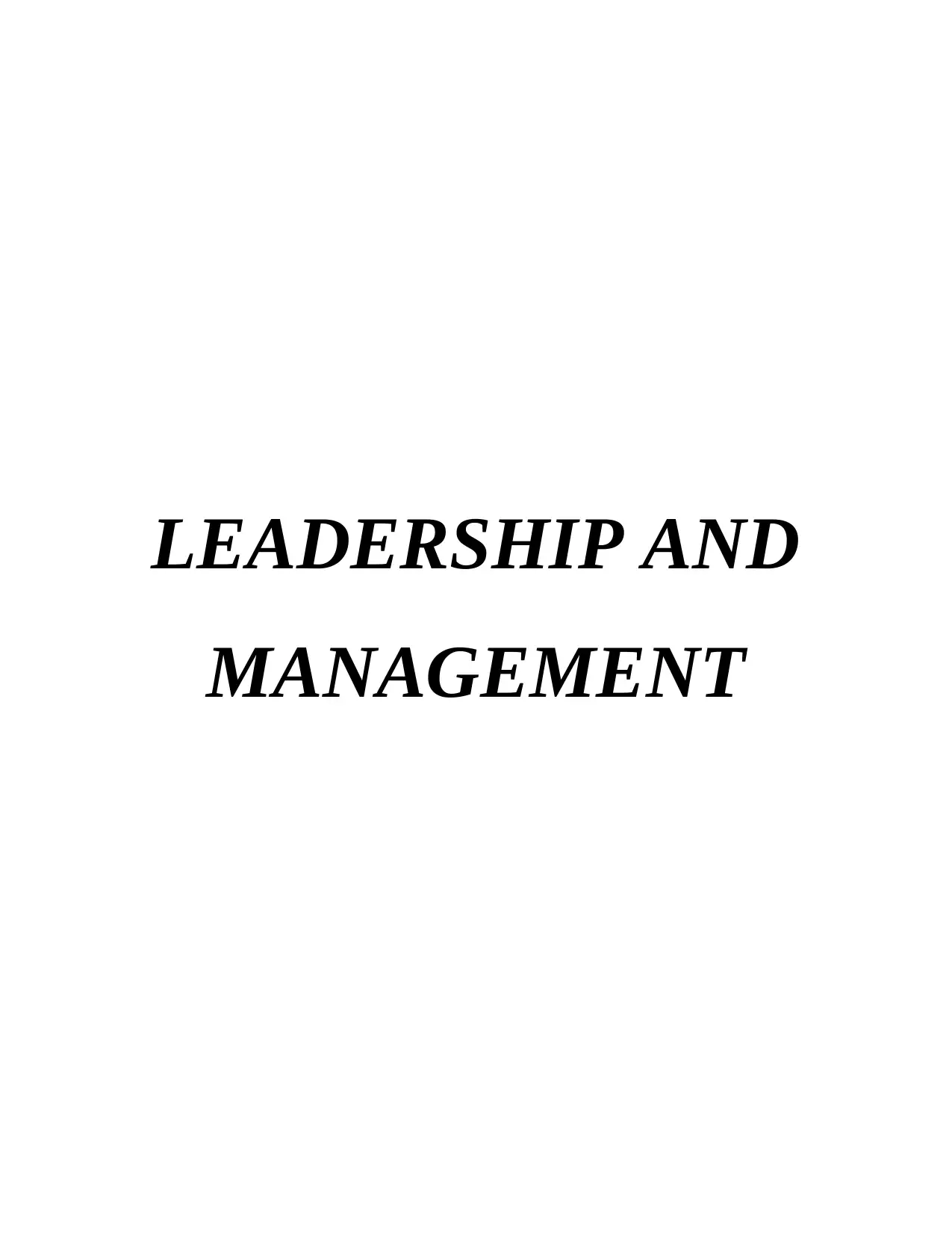
LEADERSHIP AND
MANAGEMENT
MANAGEMENT
Paraphrase This Document
Need a fresh take? Get an instant paraphrase of this document with our AI Paraphraser
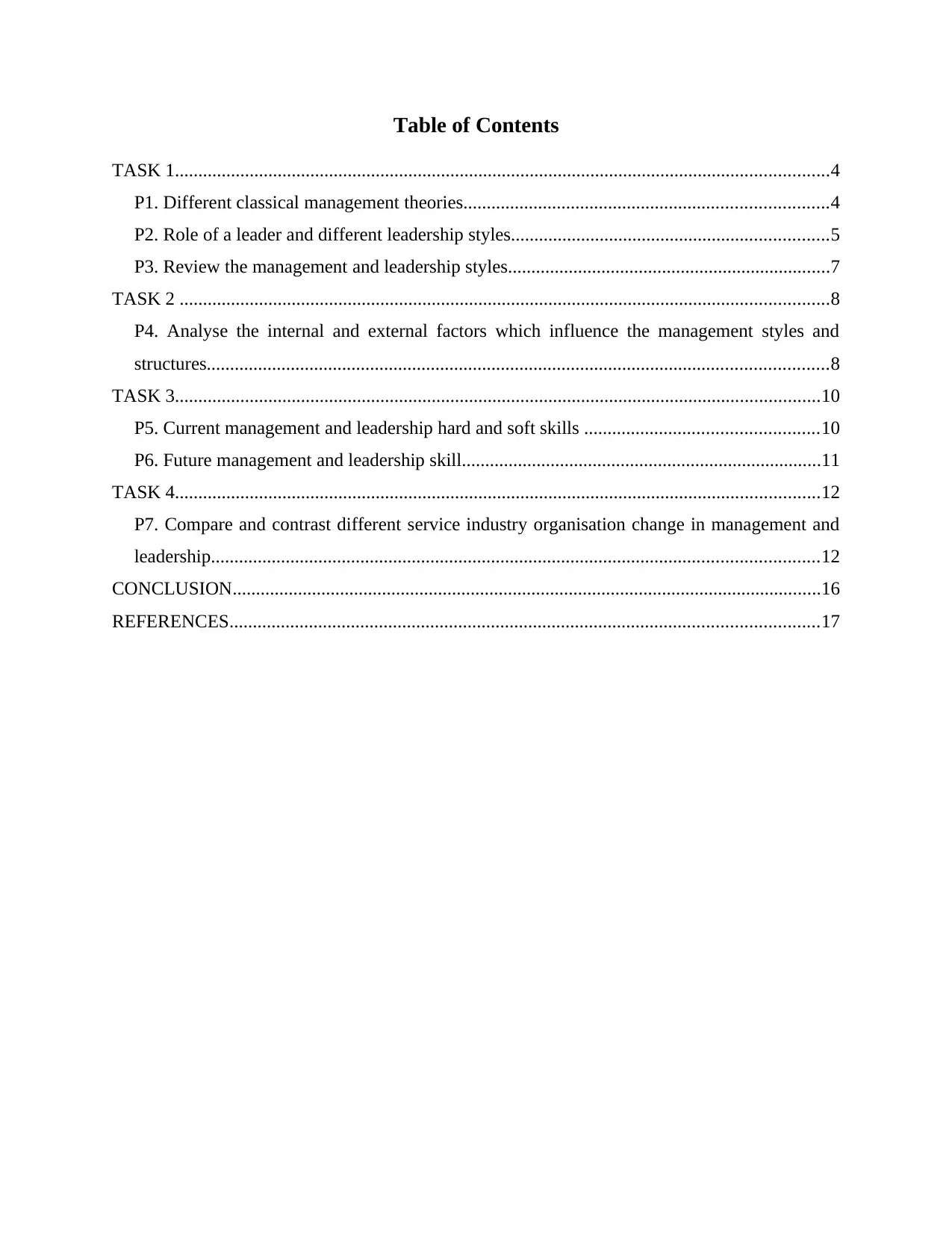
Table of Contents
TASK 1............................................................................................................................................4
P1. Different classical management theories..............................................................................4
P2. Role of a leader and different leadership styles....................................................................5
P3. Review the management and leadership styles.....................................................................7
TASK 2 ...........................................................................................................................................8
P4. Analyse the internal and external factors which influence the management styles and
structures.....................................................................................................................................8
TASK 3..........................................................................................................................................10
P5. Current management and leadership hard and soft skills ..................................................10
P6. Future management and leadership skill.............................................................................11
TASK 4..........................................................................................................................................12
P7. Compare and contrast different service industry organisation change in management and
leadership..................................................................................................................................12
CONCLUSION..............................................................................................................................16
REFERENCES..............................................................................................................................17
TASK 1............................................................................................................................................4
P1. Different classical management theories..............................................................................4
P2. Role of a leader and different leadership styles....................................................................5
P3. Review the management and leadership styles.....................................................................7
TASK 2 ...........................................................................................................................................8
P4. Analyse the internal and external factors which influence the management styles and
structures.....................................................................................................................................8
TASK 3..........................................................................................................................................10
P5. Current management and leadership hard and soft skills ..................................................10
P6. Future management and leadership skill.............................................................................11
TASK 4..........................................................................................................................................12
P7. Compare and contrast different service industry organisation change in management and
leadership..................................................................................................................................12
CONCLUSION..............................................................................................................................16
REFERENCES..............................................................................................................................17

⊘ This is a preview!⊘
Do you want full access?
Subscribe today to unlock all pages.

Trusted by 1+ million students worldwide
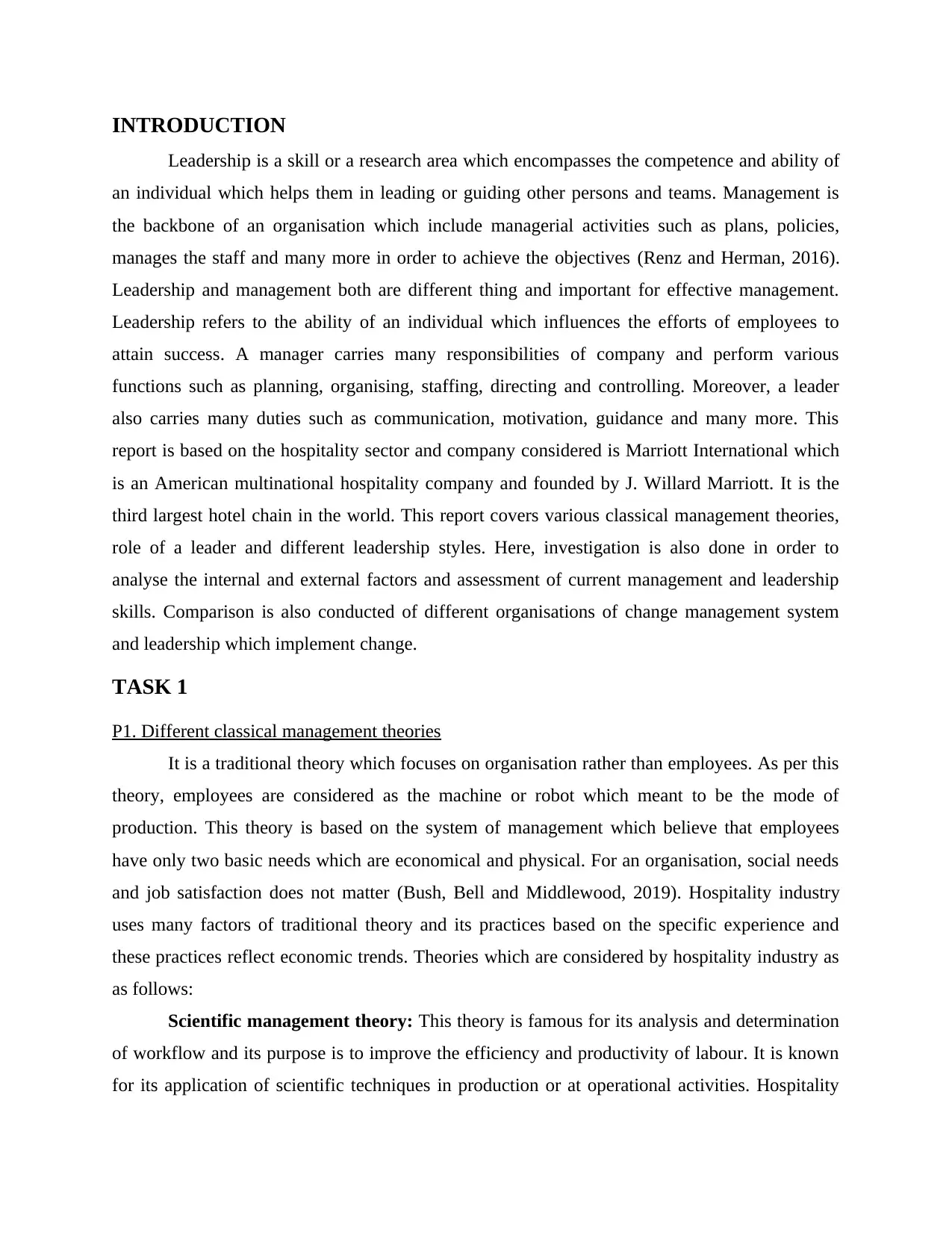
INTRODUCTION
Leadership is a skill or a research area which encompasses the competence and ability of
an individual which helps them in leading or guiding other persons and teams. Management is
the backbone of an organisation which include managerial activities such as plans, policies,
manages the staff and many more in order to achieve the objectives (Renz and Herman, 2016).
Leadership and management both are different thing and important for effective management.
Leadership refers to the ability of an individual which influences the efforts of employees to
attain success. A manager carries many responsibilities of company and perform various
functions such as planning, organising, staffing, directing and controlling. Moreover, a leader
also carries many duties such as communication, motivation, guidance and many more. This
report is based on the hospitality sector and company considered is Marriott International which
is an American multinational hospitality company and founded by J. Willard Marriott. It is the
third largest hotel chain in the world. This report covers various classical management theories,
role of a leader and different leadership styles. Here, investigation is also done in order to
analyse the internal and external factors and assessment of current management and leadership
skills. Comparison is also conducted of different organisations of change management system
and leadership which implement change.
TASK 1
P1. Different classical management theories
It is a traditional theory which focuses on organisation rather than employees. As per this
theory, employees are considered as the machine or robot which meant to be the mode of
production. This theory is based on the system of management which believe that employees
have only two basic needs which are economical and physical. For an organisation, social needs
and job satisfaction does not matter (Bush, Bell and Middlewood, 2019). Hospitality industry
uses many factors of traditional theory and its practices based on the specific experience and
these practices reflect economic trends. Theories which are considered by hospitality industry as
as follows:
Scientific management theory: This theory is famous for its analysis and determination
of workflow and its purpose is to improve the efficiency and productivity of labour. It is known
for its application of scientific techniques in production or at operational activities. Hospitality
Leadership is a skill or a research area which encompasses the competence and ability of
an individual which helps them in leading or guiding other persons and teams. Management is
the backbone of an organisation which include managerial activities such as plans, policies,
manages the staff and many more in order to achieve the objectives (Renz and Herman, 2016).
Leadership and management both are different thing and important for effective management.
Leadership refers to the ability of an individual which influences the efforts of employees to
attain success. A manager carries many responsibilities of company and perform various
functions such as planning, organising, staffing, directing and controlling. Moreover, a leader
also carries many duties such as communication, motivation, guidance and many more. This
report is based on the hospitality sector and company considered is Marriott International which
is an American multinational hospitality company and founded by J. Willard Marriott. It is the
third largest hotel chain in the world. This report covers various classical management theories,
role of a leader and different leadership styles. Here, investigation is also done in order to
analyse the internal and external factors and assessment of current management and leadership
skills. Comparison is also conducted of different organisations of change management system
and leadership which implement change.
TASK 1
P1. Different classical management theories
It is a traditional theory which focuses on organisation rather than employees. As per this
theory, employees are considered as the machine or robot which meant to be the mode of
production. This theory is based on the system of management which believe that employees
have only two basic needs which are economical and physical. For an organisation, social needs
and job satisfaction does not matter (Bush, Bell and Middlewood, 2019). Hospitality industry
uses many factors of traditional theory and its practices based on the specific experience and
these practices reflect economic trends. Theories which are considered by hospitality industry as
as follows:
Scientific management theory: This theory is famous for its analysis and determination
of workflow and its purpose is to improve the efficiency and productivity of labour. It is known
for its application of scientific techniques in production or at operational activities. Hospitality
Paraphrase This Document
Need a fresh take? Get an instant paraphrase of this document with our AI Paraphraser
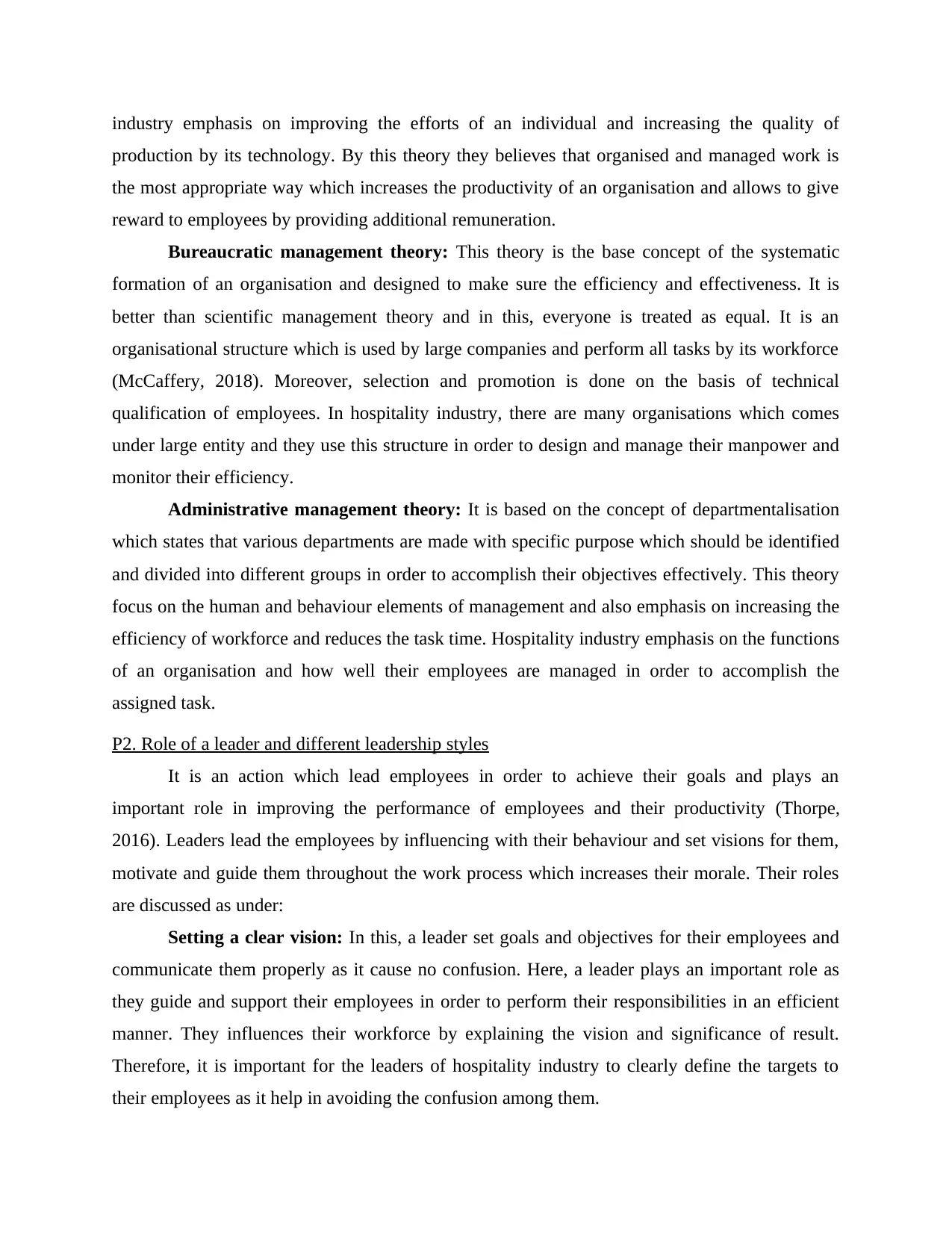
industry emphasis on improving the efforts of an individual and increasing the quality of
production by its technology. By this theory they believes that organised and managed work is
the most appropriate way which increases the productivity of an organisation and allows to give
reward to employees by providing additional remuneration.
Bureaucratic management theory: This theory is the base concept of the systematic
formation of an organisation and designed to make sure the efficiency and effectiveness. It is
better than scientific management theory and in this, everyone is treated as equal. It is an
organisational structure which is used by large companies and perform all tasks by its workforce
(McCaffery, 2018). Moreover, selection and promotion is done on the basis of technical
qualification of employees. In hospitality industry, there are many organisations which comes
under large entity and they use this structure in order to design and manage their manpower and
monitor their efficiency.
Administrative management theory: It is based on the concept of departmentalisation
which states that various departments are made with specific purpose which should be identified
and divided into different groups in order to accomplish their objectives effectively. This theory
focus on the human and behaviour elements of management and also emphasis on increasing the
efficiency of workforce and reduces the task time. Hospitality industry emphasis on the functions
of an organisation and how well their employees are managed in order to accomplish the
assigned task.
P2. Role of a leader and different leadership styles
It is an action which lead employees in order to achieve their goals and plays an
important role in improving the performance of employees and their productivity (Thorpe,
2016). Leaders lead the employees by influencing with their behaviour and set visions for them,
motivate and guide them throughout the work process which increases their morale. Their roles
are discussed as under:
Setting a clear vision: In this, a leader set goals and objectives for their employees and
communicate them properly as it cause no confusion. Here, a leader plays an important role as
they guide and support their employees in order to perform their responsibilities in an efficient
manner. They influences their workforce by explaining the vision and significance of result.
Therefore, it is important for the leaders of hospitality industry to clearly define the targets to
their employees as it help in avoiding the confusion among them.
production by its technology. By this theory they believes that organised and managed work is
the most appropriate way which increases the productivity of an organisation and allows to give
reward to employees by providing additional remuneration.
Bureaucratic management theory: This theory is the base concept of the systematic
formation of an organisation and designed to make sure the efficiency and effectiveness. It is
better than scientific management theory and in this, everyone is treated as equal. It is an
organisational structure which is used by large companies and perform all tasks by its workforce
(McCaffery, 2018). Moreover, selection and promotion is done on the basis of technical
qualification of employees. In hospitality industry, there are many organisations which comes
under large entity and they use this structure in order to design and manage their manpower and
monitor their efficiency.
Administrative management theory: It is based on the concept of departmentalisation
which states that various departments are made with specific purpose which should be identified
and divided into different groups in order to accomplish their objectives effectively. This theory
focus on the human and behaviour elements of management and also emphasis on increasing the
efficiency of workforce and reduces the task time. Hospitality industry emphasis on the functions
of an organisation and how well their employees are managed in order to accomplish the
assigned task.
P2. Role of a leader and different leadership styles
It is an action which lead employees in order to achieve their goals and plays an
important role in improving the performance of employees and their productivity (Thorpe,
2016). Leaders lead the employees by influencing with their behaviour and set visions for them,
motivate and guide them throughout the work process which increases their morale. Their roles
are discussed as under:
Setting a clear vision: In this, a leader set goals and objectives for their employees and
communicate them properly as it cause no confusion. Here, a leader plays an important role as
they guide and support their employees in order to perform their responsibilities in an efficient
manner. They influences their workforce by explaining the vision and significance of result.
Therefore, it is important for the leaders of hospitality industry to clearly define the targets to
their employees as it help in avoiding the confusion among them.
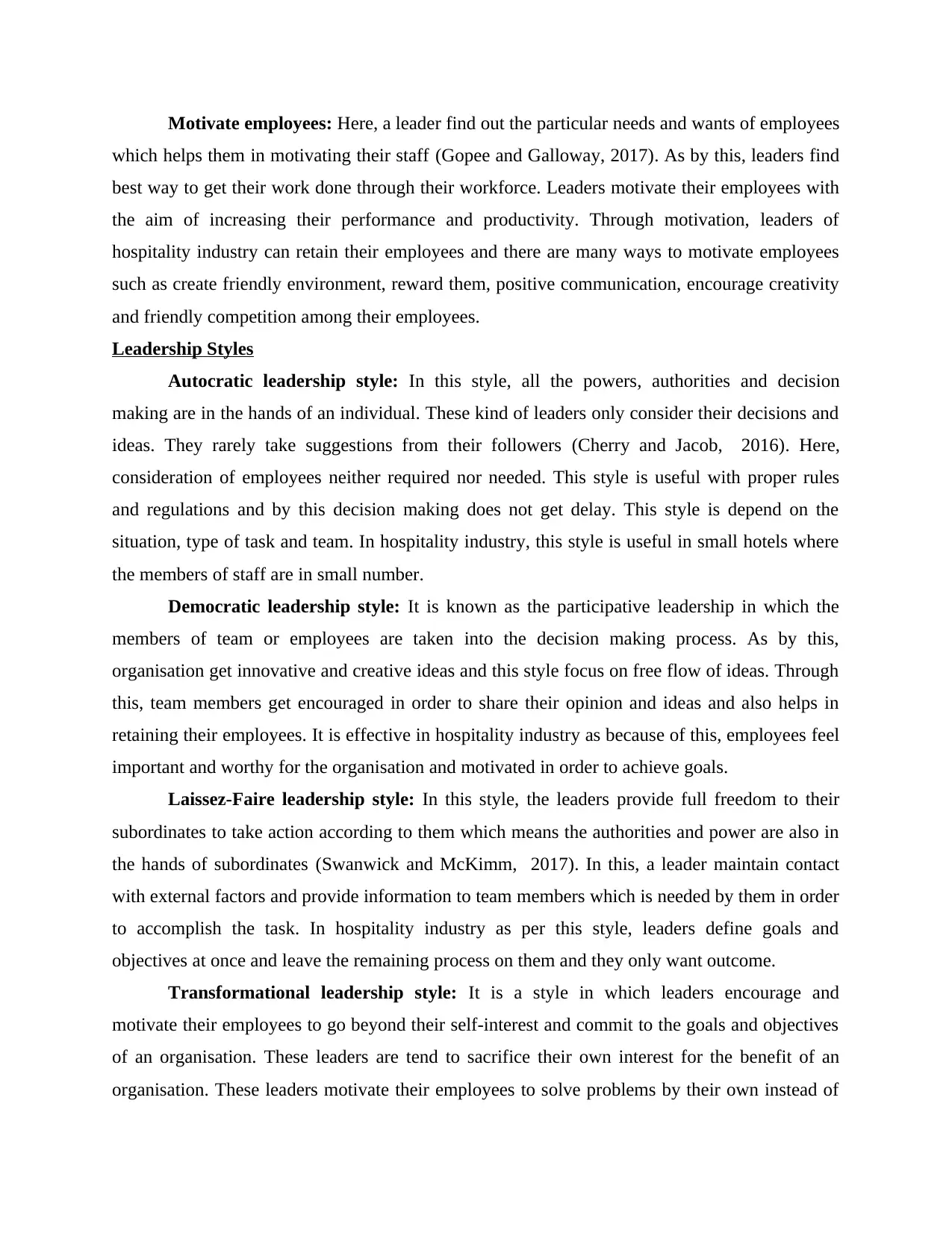
Motivate employees: Here, a leader find out the particular needs and wants of employees
which helps them in motivating their staff (Gopee and Galloway, 2017). As by this, leaders find
best way to get their work done through their workforce. Leaders motivate their employees with
the aim of increasing their performance and productivity. Through motivation, leaders of
hospitality industry can retain their employees and there are many ways to motivate employees
such as create friendly environment, reward them, positive communication, encourage creativity
and friendly competition among their employees.
Leadership Styles
Autocratic leadership style: In this style, all the powers, authorities and decision
making are in the hands of an individual. These kind of leaders only consider their decisions and
ideas. They rarely take suggestions from their followers (Cherry and Jacob, 2016). Here,
consideration of employees neither required nor needed. This style is useful with proper rules
and regulations and by this decision making does not get delay. This style is depend on the
situation, type of task and team. In hospitality industry, this style is useful in small hotels where
the members of staff are in small number.
Democratic leadership style: It is known as the participative leadership in which the
members of team or employees are taken into the decision making process. As by this,
organisation get innovative and creative ideas and this style focus on free flow of ideas. Through
this, team members get encouraged in order to share their opinion and ideas and also helps in
retaining their employees. It is effective in hospitality industry as because of this, employees feel
important and worthy for the organisation and motivated in order to achieve goals.
Laissez-Faire leadership style: In this style, the leaders provide full freedom to their
subordinates to take action according to them which means the authorities and power are also in
the hands of subordinates (Swanwick and McKimm, 2017). In this, a leader maintain contact
with external factors and provide information to team members which is needed by them in order
to accomplish the task. In hospitality industry as per this style, leaders define goals and
objectives at once and leave the remaining process on them and they only want outcome.
Transformational leadership style: It is a style in which leaders encourage and
motivate their employees to go beyond their self-interest and commit to the goals and objectives
of an organisation. These leaders are tend to sacrifice their own interest for the benefit of an
organisation. These leaders motivate their employees to solve problems by their own instead of
which helps them in motivating their staff (Gopee and Galloway, 2017). As by this, leaders find
best way to get their work done through their workforce. Leaders motivate their employees with
the aim of increasing their performance and productivity. Through motivation, leaders of
hospitality industry can retain their employees and there are many ways to motivate employees
such as create friendly environment, reward them, positive communication, encourage creativity
and friendly competition among their employees.
Leadership Styles
Autocratic leadership style: In this style, all the powers, authorities and decision
making are in the hands of an individual. These kind of leaders only consider their decisions and
ideas. They rarely take suggestions from their followers (Cherry and Jacob, 2016). Here,
consideration of employees neither required nor needed. This style is useful with proper rules
and regulations and by this decision making does not get delay. This style is depend on the
situation, type of task and team. In hospitality industry, this style is useful in small hotels where
the members of staff are in small number.
Democratic leadership style: It is known as the participative leadership in which the
members of team or employees are taken into the decision making process. As by this,
organisation get innovative and creative ideas and this style focus on free flow of ideas. Through
this, team members get encouraged in order to share their opinion and ideas and also helps in
retaining their employees. It is effective in hospitality industry as because of this, employees feel
important and worthy for the organisation and motivated in order to achieve goals.
Laissez-Faire leadership style: In this style, the leaders provide full freedom to their
subordinates to take action according to them which means the authorities and power are also in
the hands of subordinates (Swanwick and McKimm, 2017). In this, a leader maintain contact
with external factors and provide information to team members which is needed by them in order
to accomplish the task. In hospitality industry as per this style, leaders define goals and
objectives at once and leave the remaining process on them and they only want outcome.
Transformational leadership style: It is a style in which leaders encourage and
motivate their employees to go beyond their self-interest and commit to the goals and objectives
of an organisation. These leaders are tend to sacrifice their own interest for the benefit of an
organisation. These leaders motivate their employees to solve problems by their own instead of
⊘ This is a preview!⊘
Do you want full access?
Subscribe today to unlock all pages.

Trusted by 1+ million students worldwide
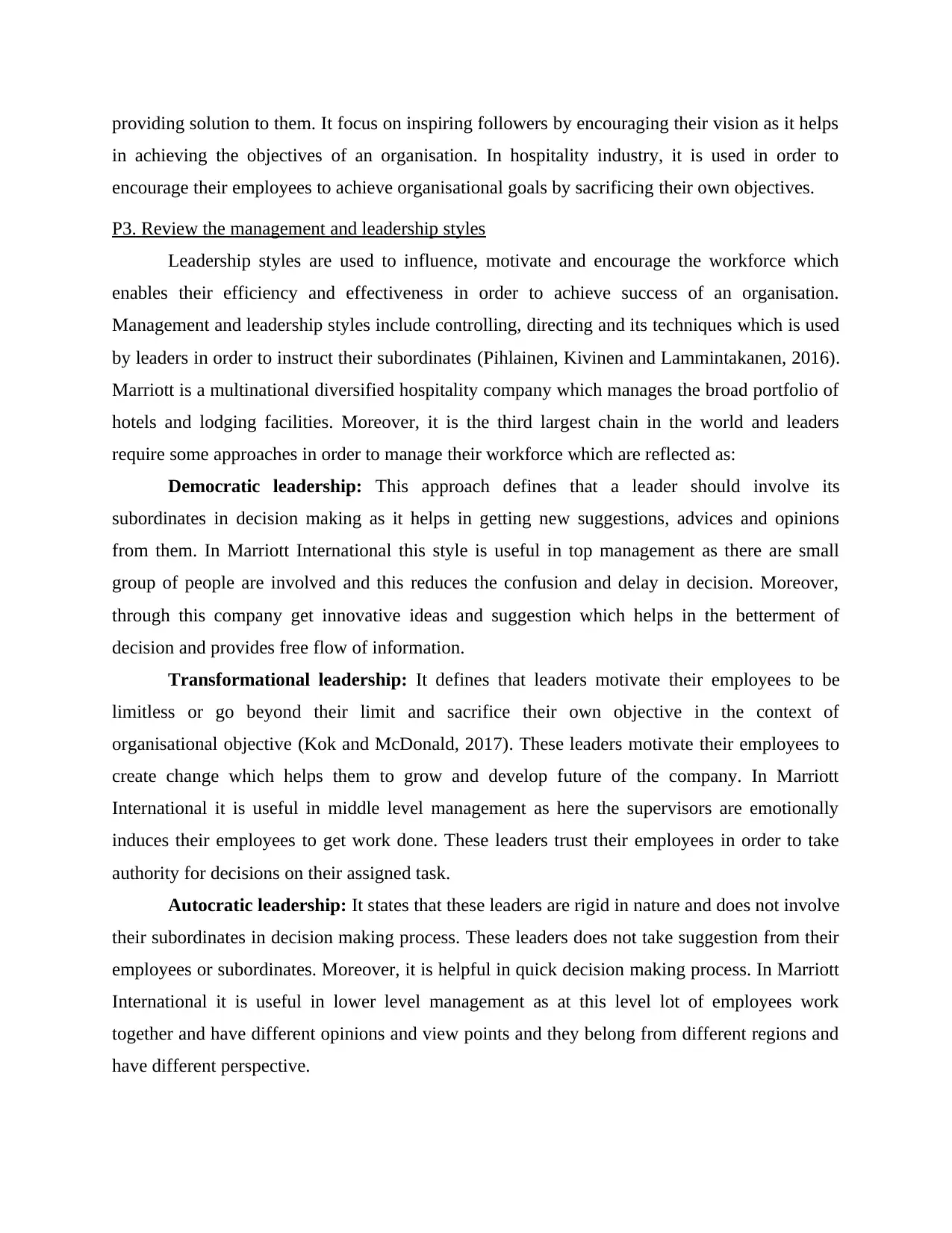
providing solution to them. It focus on inspiring followers by encouraging their vision as it helps
in achieving the objectives of an organisation. In hospitality industry, it is used in order to
encourage their employees to achieve organisational goals by sacrificing their own objectives.
P3. Review the management and leadership styles
Leadership styles are used to influence, motivate and encourage the workforce which
enables their efficiency and effectiveness in order to achieve success of an organisation.
Management and leadership styles include controlling, directing and its techniques which is used
by leaders in order to instruct their subordinates (Pihlainen, Kivinen and Lammintakanen, 2016).
Marriott is a multinational diversified hospitality company which manages the broad portfolio of
hotels and lodging facilities. Moreover, it is the third largest chain in the world and leaders
require some approaches in order to manage their workforce which are reflected as:
Democratic leadership: This approach defines that a leader should involve its
subordinates in decision making as it helps in getting new suggestions, advices and opinions
from them. In Marriott International this style is useful in top management as there are small
group of people are involved and this reduces the confusion and delay in decision. Moreover,
through this company get innovative ideas and suggestion which helps in the betterment of
decision and provides free flow of information.
Transformational leadership: It defines that leaders motivate their employees to be
limitless or go beyond their limit and sacrifice their own objective in the context of
organisational objective (Kok and McDonald, 2017). These leaders motivate their employees to
create change which helps them to grow and develop future of the company. In Marriott
International it is useful in middle level management as here the supervisors are emotionally
induces their employees to get work done. These leaders trust their employees in order to take
authority for decisions on their assigned task.
Autocratic leadership: It states that these leaders are rigid in nature and does not involve
their subordinates in decision making process. These leaders does not take suggestion from their
employees or subordinates. Moreover, it is helpful in quick decision making process. In Marriott
International it is useful in lower level management as at this level lot of employees work
together and have different opinions and view points and they belong from different regions and
have different perspective.
in achieving the objectives of an organisation. In hospitality industry, it is used in order to
encourage their employees to achieve organisational goals by sacrificing their own objectives.
P3. Review the management and leadership styles
Leadership styles are used to influence, motivate and encourage the workforce which
enables their efficiency and effectiveness in order to achieve success of an organisation.
Management and leadership styles include controlling, directing and its techniques which is used
by leaders in order to instruct their subordinates (Pihlainen, Kivinen and Lammintakanen, 2016).
Marriott is a multinational diversified hospitality company which manages the broad portfolio of
hotels and lodging facilities. Moreover, it is the third largest chain in the world and leaders
require some approaches in order to manage their workforce which are reflected as:
Democratic leadership: This approach defines that a leader should involve its
subordinates in decision making as it helps in getting new suggestions, advices and opinions
from them. In Marriott International this style is useful in top management as there are small
group of people are involved and this reduces the confusion and delay in decision. Moreover,
through this company get innovative ideas and suggestion which helps in the betterment of
decision and provides free flow of information.
Transformational leadership: It defines that leaders motivate their employees to be
limitless or go beyond their limit and sacrifice their own objective in the context of
organisational objective (Kok and McDonald, 2017). These leaders motivate their employees to
create change which helps them to grow and develop future of the company. In Marriott
International it is useful in middle level management as here the supervisors are emotionally
induces their employees to get work done. These leaders trust their employees in order to take
authority for decisions on their assigned task.
Autocratic leadership: It states that these leaders are rigid in nature and does not involve
their subordinates in decision making process. These leaders does not take suggestion from their
employees or subordinates. Moreover, it is helpful in quick decision making process. In Marriott
International it is useful in lower level management as at this level lot of employees work
together and have different opinions and view points and they belong from different regions and
have different perspective.
Paraphrase This Document
Need a fresh take? Get an instant paraphrase of this document with our AI Paraphraser
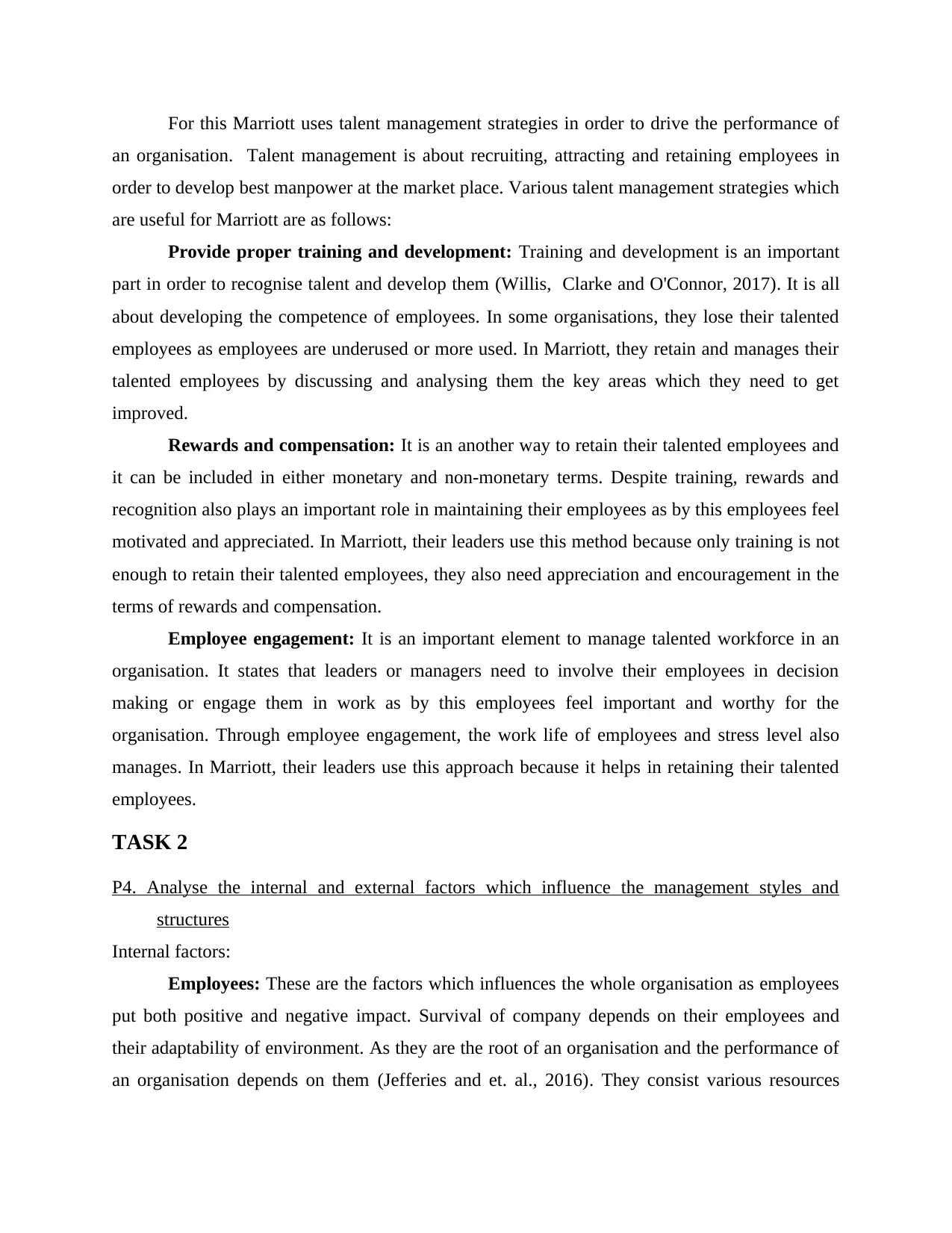
For this Marriott uses talent management strategies in order to drive the performance of
an organisation. Talent management is about recruiting, attracting and retaining employees in
order to develop best manpower at the market place. Various talent management strategies which
are useful for Marriott are as follows:
Provide proper training and development: Training and development is an important
part in order to recognise talent and develop them (Willis, Clarke and O'Connor, 2017). It is all
about developing the competence of employees. In some organisations, they lose their talented
employees as employees are underused or more used. In Marriott, they retain and manages their
talented employees by discussing and analysing them the key areas which they need to get
improved.
Rewards and compensation: It is an another way to retain their talented employees and
it can be included in either monetary and non-monetary terms. Despite training, rewards and
recognition also plays an important role in maintaining their employees as by this employees feel
motivated and appreciated. In Marriott, their leaders use this method because only training is not
enough to retain their talented employees, they also need appreciation and encouragement in the
terms of rewards and compensation.
Employee engagement: It is an important element to manage talented workforce in an
organisation. It states that leaders or managers need to involve their employees in decision
making or engage them in work as by this employees feel important and worthy for the
organisation. Through employee engagement, the work life of employees and stress level also
manages. In Marriott, their leaders use this approach because it helps in retaining their talented
employees.
TASK 2
P4. Analyse the internal and external factors which influence the management styles and
structures
Internal factors:
Employees: These are the factors which influences the whole organisation as employees
put both positive and negative impact. Survival of company depends on their employees and
their adaptability of environment. As they are the root of an organisation and the performance of
an organisation depends on them (Jefferies and et. al., 2016). They consist various resources
an organisation. Talent management is about recruiting, attracting and retaining employees in
order to develop best manpower at the market place. Various talent management strategies which
are useful for Marriott are as follows:
Provide proper training and development: Training and development is an important
part in order to recognise talent and develop them (Willis, Clarke and O'Connor, 2017). It is all
about developing the competence of employees. In some organisations, they lose their talented
employees as employees are underused or more used. In Marriott, they retain and manages their
talented employees by discussing and analysing them the key areas which they need to get
improved.
Rewards and compensation: It is an another way to retain their talented employees and
it can be included in either monetary and non-monetary terms. Despite training, rewards and
recognition also plays an important role in maintaining their employees as by this employees feel
motivated and appreciated. In Marriott, their leaders use this method because only training is not
enough to retain their talented employees, they also need appreciation and encouragement in the
terms of rewards and compensation.
Employee engagement: It is an important element to manage talented workforce in an
organisation. It states that leaders or managers need to involve their employees in decision
making or engage them in work as by this employees feel important and worthy for the
organisation. Through employee engagement, the work life of employees and stress level also
manages. In Marriott, their leaders use this approach because it helps in retaining their talented
employees.
TASK 2
P4. Analyse the internal and external factors which influence the management styles and
structures
Internal factors:
Employees: These are the factors which influences the whole organisation as employees
put both positive and negative impact. Survival of company depends on their employees and
their adaptability of environment. As they are the root of an organisation and the performance of
an organisation depends on them (Jefferies and et. al., 2016). They consist various resources
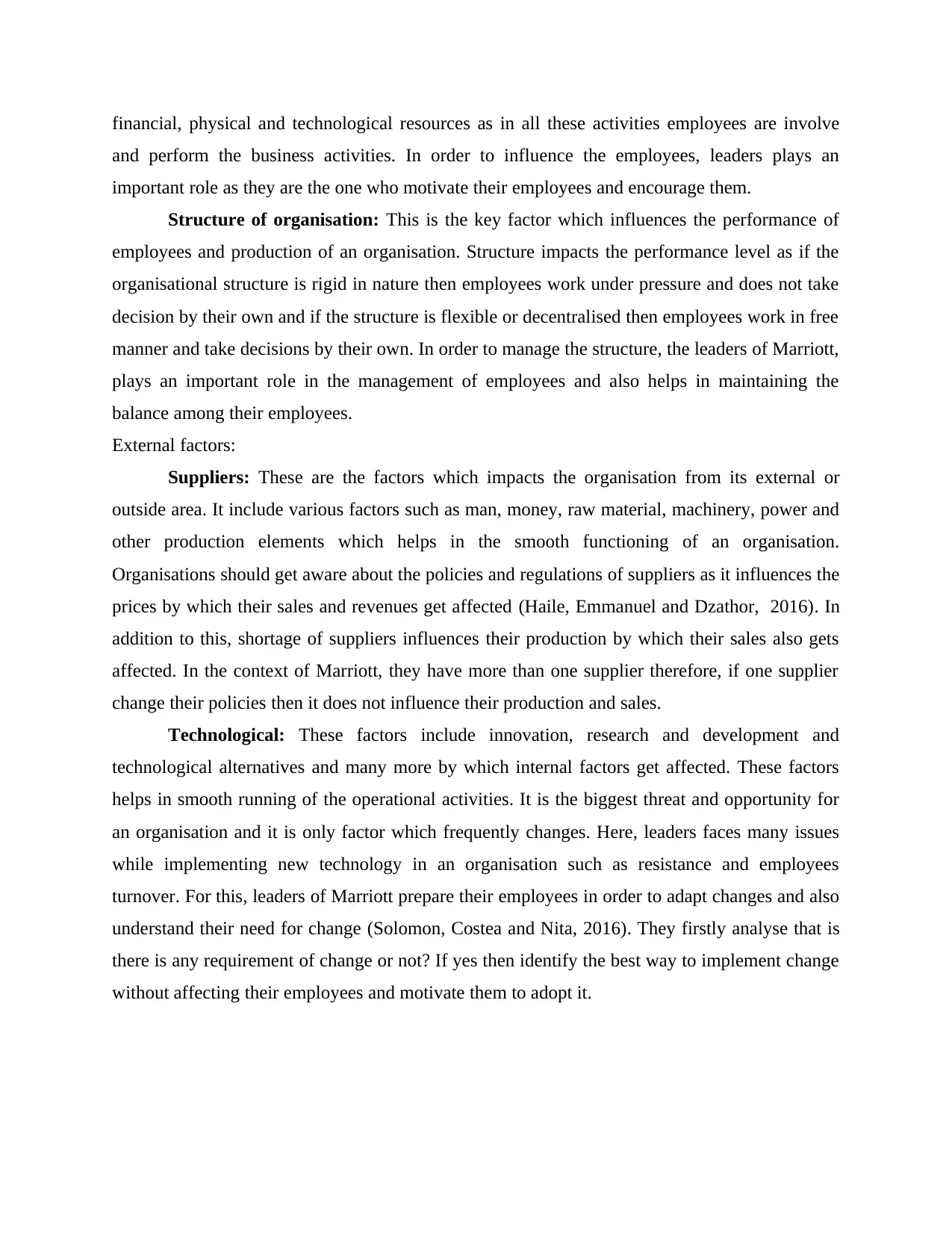
financial, physical and technological resources as in all these activities employees are involve
and perform the business activities. In order to influence the employees, leaders plays an
important role as they are the one who motivate their employees and encourage them.
Structure of organisation: This is the key factor which influences the performance of
employees and production of an organisation. Structure impacts the performance level as if the
organisational structure is rigid in nature then employees work under pressure and does not take
decision by their own and if the structure is flexible or decentralised then employees work in free
manner and take decisions by their own. In order to manage the structure, the leaders of Marriott,
plays an important role in the management of employees and also helps in maintaining the
balance among their employees.
External factors:
Suppliers: These are the factors which impacts the organisation from its external or
outside area. It include various factors such as man, money, raw material, machinery, power and
other production elements which helps in the smooth functioning of an organisation.
Organisations should get aware about the policies and regulations of suppliers as it influences the
prices by which their sales and revenues get affected (Haile, Emmanuel and Dzathor, 2016). In
addition to this, shortage of suppliers influences their production by which their sales also gets
affected. In the context of Marriott, they have more than one supplier therefore, if one supplier
change their policies then it does not influence their production and sales.
Technological: These factors include innovation, research and development and
technological alternatives and many more by which internal factors get affected. These factors
helps in smooth running of the operational activities. It is the biggest threat and opportunity for
an organisation and it is only factor which frequently changes. Here, leaders faces many issues
while implementing new technology in an organisation such as resistance and employees
turnover. For this, leaders of Marriott prepare their employees in order to adapt changes and also
understand their need for change (Solomon, Costea and Nita, 2016). They firstly analyse that is
there is any requirement of change or not? If yes then identify the best way to implement change
without affecting their employees and motivate them to adopt it.
and perform the business activities. In order to influence the employees, leaders plays an
important role as they are the one who motivate their employees and encourage them.
Structure of organisation: This is the key factor which influences the performance of
employees and production of an organisation. Structure impacts the performance level as if the
organisational structure is rigid in nature then employees work under pressure and does not take
decision by their own and if the structure is flexible or decentralised then employees work in free
manner and take decisions by their own. In order to manage the structure, the leaders of Marriott,
plays an important role in the management of employees and also helps in maintaining the
balance among their employees.
External factors:
Suppliers: These are the factors which impacts the organisation from its external or
outside area. It include various factors such as man, money, raw material, machinery, power and
other production elements which helps in the smooth functioning of an organisation.
Organisations should get aware about the policies and regulations of suppliers as it influences the
prices by which their sales and revenues get affected (Haile, Emmanuel and Dzathor, 2016). In
addition to this, shortage of suppliers influences their production by which their sales also gets
affected. In the context of Marriott, they have more than one supplier therefore, if one supplier
change their policies then it does not influence their production and sales.
Technological: These factors include innovation, research and development and
technological alternatives and many more by which internal factors get affected. These factors
helps in smooth running of the operational activities. It is the biggest threat and opportunity for
an organisation and it is only factor which frequently changes. Here, leaders faces many issues
while implementing new technology in an organisation such as resistance and employees
turnover. For this, leaders of Marriott prepare their employees in order to adapt changes and also
understand their need for change (Solomon, Costea and Nita, 2016). They firstly analyse that is
there is any requirement of change or not? If yes then identify the best way to implement change
without affecting their employees and motivate them to adopt it.
⊘ This is a preview!⊘
Do you want full access?
Subscribe today to unlock all pages.

Trusted by 1+ million students worldwide
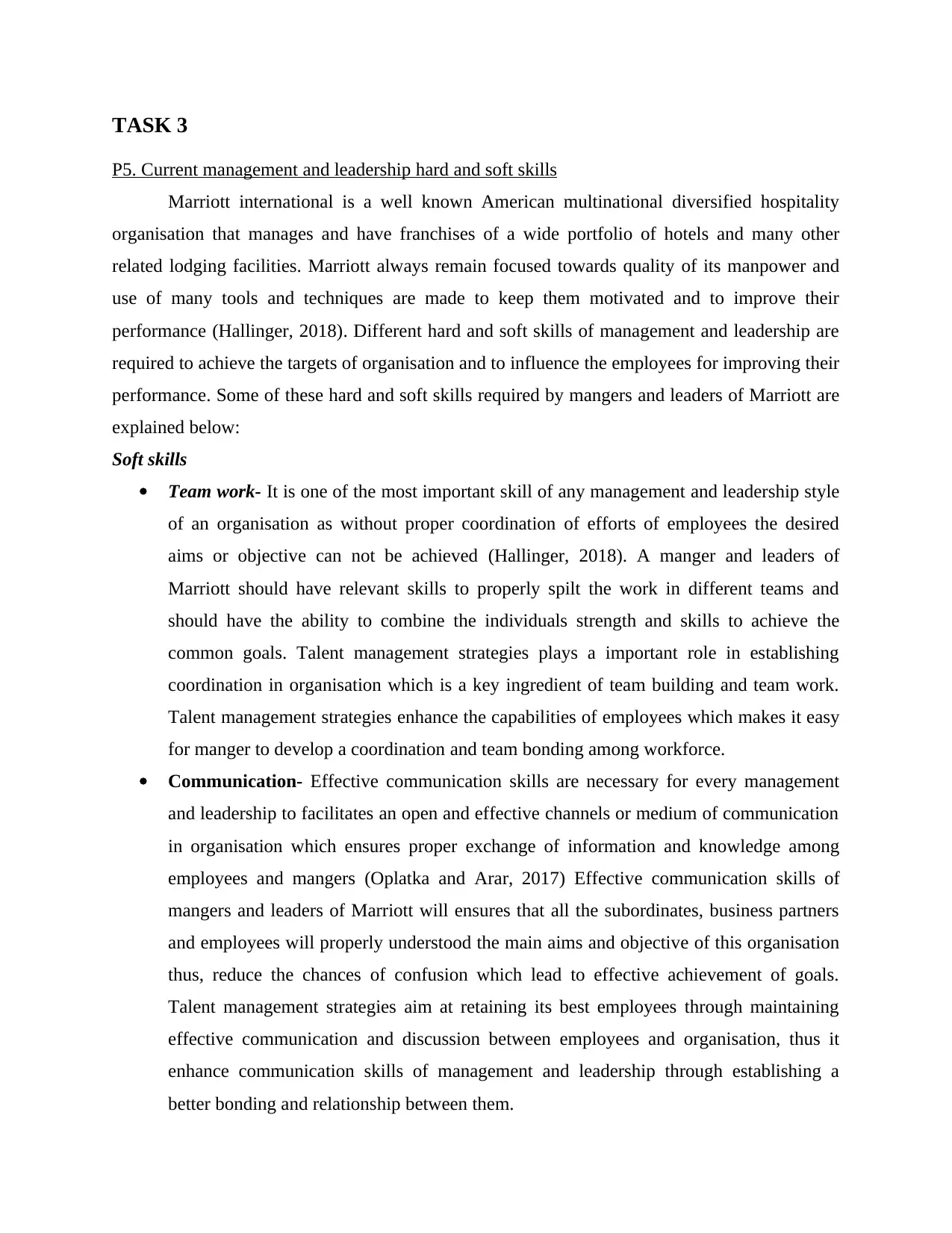
TASK 3
P5. Current management and leadership hard and soft skills
Marriott international is a well known American multinational diversified hospitality
organisation that manages and have franchises of a wide portfolio of hotels and many other
related lodging facilities. Marriott always remain focused towards quality of its manpower and
use of many tools and techniques are made to keep them motivated and to improve their
performance (Hallinger, 2018). Different hard and soft skills of management and leadership are
required to achieve the targets of organisation and to influence the employees for improving their
performance. Some of these hard and soft skills required by mangers and leaders of Marriott are
explained below:
Soft skills
Team work- It is one of the most important skill of any management and leadership style
of an organisation as without proper coordination of efforts of employees the desired
aims or objective can not be achieved (Hallinger, 2018). A manger and leaders of
Marriott should have relevant skills to properly spilt the work in different teams and
should have the ability to combine the individuals strength and skills to achieve the
common goals. Talent management strategies plays a important role in establishing
coordination in organisation which is a key ingredient of team building and team work.
Talent management strategies enhance the capabilities of employees which makes it easy
for manger to develop a coordination and team bonding among workforce.
Communication- Effective communication skills are necessary for every management
and leadership to facilitates an open and effective channels or medium of communication
in organisation which ensures proper exchange of information and knowledge among
employees and mangers (Oplatka and Arar, 2017) Effective communication skills of
mangers and leaders of Marriott will ensures that all the subordinates, business partners
and employees will properly understood the main aims and objective of this organisation
thus, reduce the chances of confusion which lead to effective achievement of goals.
Talent management strategies aim at retaining its best employees through maintaining
effective communication and discussion between employees and organisation, thus it
enhance communication skills of management and leadership through establishing a
better bonding and relationship between them.
P5. Current management and leadership hard and soft skills
Marriott international is a well known American multinational diversified hospitality
organisation that manages and have franchises of a wide portfolio of hotels and many other
related lodging facilities. Marriott always remain focused towards quality of its manpower and
use of many tools and techniques are made to keep them motivated and to improve their
performance (Hallinger, 2018). Different hard and soft skills of management and leadership are
required to achieve the targets of organisation and to influence the employees for improving their
performance. Some of these hard and soft skills required by mangers and leaders of Marriott are
explained below:
Soft skills
Team work- It is one of the most important skill of any management and leadership style
of an organisation as without proper coordination of efforts of employees the desired
aims or objective can not be achieved (Hallinger, 2018). A manger and leaders of
Marriott should have relevant skills to properly spilt the work in different teams and
should have the ability to combine the individuals strength and skills to achieve the
common goals. Talent management strategies plays a important role in establishing
coordination in organisation which is a key ingredient of team building and team work.
Talent management strategies enhance the capabilities of employees which makes it easy
for manger to develop a coordination and team bonding among workforce.
Communication- Effective communication skills are necessary for every management
and leadership to facilitates an open and effective channels or medium of communication
in organisation which ensures proper exchange of information and knowledge among
employees and mangers (Oplatka and Arar, 2017) Effective communication skills of
mangers and leaders of Marriott will ensures that all the subordinates, business partners
and employees will properly understood the main aims and objective of this organisation
thus, reduce the chances of confusion which lead to effective achievement of goals.
Talent management strategies aim at retaining its best employees through maintaining
effective communication and discussion between employees and organisation, thus it
enhance communication skills of management and leadership through establishing a
better bonding and relationship between them.
Paraphrase This Document
Need a fresh take? Get an instant paraphrase of this document with our AI Paraphraser
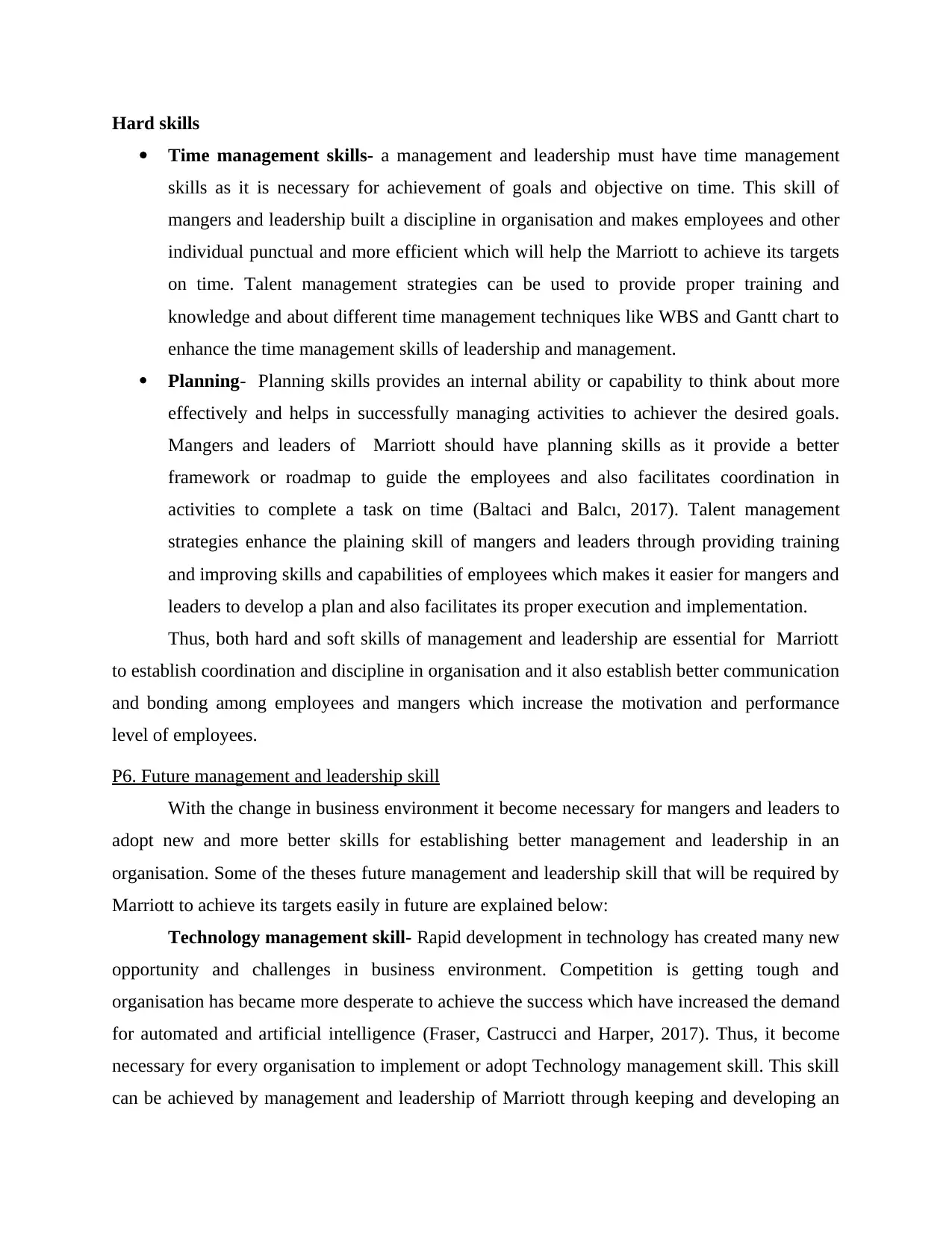
Hard skills
Time management skills- a management and leadership must have time management
skills as it is necessary for achievement of goals and objective on time. This skill of
mangers and leadership built a discipline in organisation and makes employees and other
individual punctual and more efficient which will help the Marriott to achieve its targets
on time. Talent management strategies can be used to provide proper training and
knowledge and about different time management techniques like WBS and Gantt chart to
enhance the time management skills of leadership and management.
Planning- Planning skills provides an internal ability or capability to think about more
effectively and helps in successfully managing activities to achiever the desired goals.
Mangers and leaders of Marriott should have planning skills as it provide a better
framework or roadmap to guide the employees and also facilitates coordination in
activities to complete a task on time (Baltaci and Balcı, 2017). Talent management
strategies enhance the plaining skill of mangers and leaders through providing training
and improving skills and capabilities of employees which makes it easier for mangers and
leaders to develop a plan and also facilitates its proper execution and implementation.
Thus, both hard and soft skills of management and leadership are essential for Marriott
to establish coordination and discipline in organisation and it also establish better communication
and bonding among employees and mangers which increase the motivation and performance
level of employees.
P6. Future management and leadership skill
With the change in business environment it become necessary for mangers and leaders to
adopt new and more better skills for establishing better management and leadership in an
organisation. Some of the theses future management and leadership skill that will be required by
Marriott to achieve its targets easily in future are explained below:
Technology management skill- Rapid development in technology has created many new
opportunity and challenges in business environment. Competition is getting tough and
organisation has became more desperate to achieve the success which have increased the demand
for automated and artificial intelligence (Fraser, Castrucci and Harper, 2017). Thus, it become
necessary for every organisation to implement or adopt Technology management skill. This skill
can be achieved by management and leadership of Marriott through keeping and developing an
Time management skills- a management and leadership must have time management
skills as it is necessary for achievement of goals and objective on time. This skill of
mangers and leadership built a discipline in organisation and makes employees and other
individual punctual and more efficient which will help the Marriott to achieve its targets
on time. Talent management strategies can be used to provide proper training and
knowledge and about different time management techniques like WBS and Gantt chart to
enhance the time management skills of leadership and management.
Planning- Planning skills provides an internal ability or capability to think about more
effectively and helps in successfully managing activities to achiever the desired goals.
Mangers and leaders of Marriott should have planning skills as it provide a better
framework or roadmap to guide the employees and also facilitates coordination in
activities to complete a task on time (Baltaci and Balcı, 2017). Talent management
strategies enhance the plaining skill of mangers and leaders through providing training
and improving skills and capabilities of employees which makes it easier for mangers and
leaders to develop a plan and also facilitates its proper execution and implementation.
Thus, both hard and soft skills of management and leadership are essential for Marriott
to establish coordination and discipline in organisation and it also establish better communication
and bonding among employees and mangers which increase the motivation and performance
level of employees.
P6. Future management and leadership skill
With the change in business environment it become necessary for mangers and leaders to
adopt new and more better skills for establishing better management and leadership in an
organisation. Some of the theses future management and leadership skill that will be required by
Marriott to achieve its targets easily in future are explained below:
Technology management skill- Rapid development in technology has created many new
opportunity and challenges in business environment. Competition is getting tough and
organisation has became more desperate to achieve the success which have increased the demand
for automated and artificial intelligence (Fraser, Castrucci and Harper, 2017). Thus, it become
necessary for every organisation to implement or adopt Technology management skill. This skill
can be achieved by management and leadership of Marriott through keeping and developing an
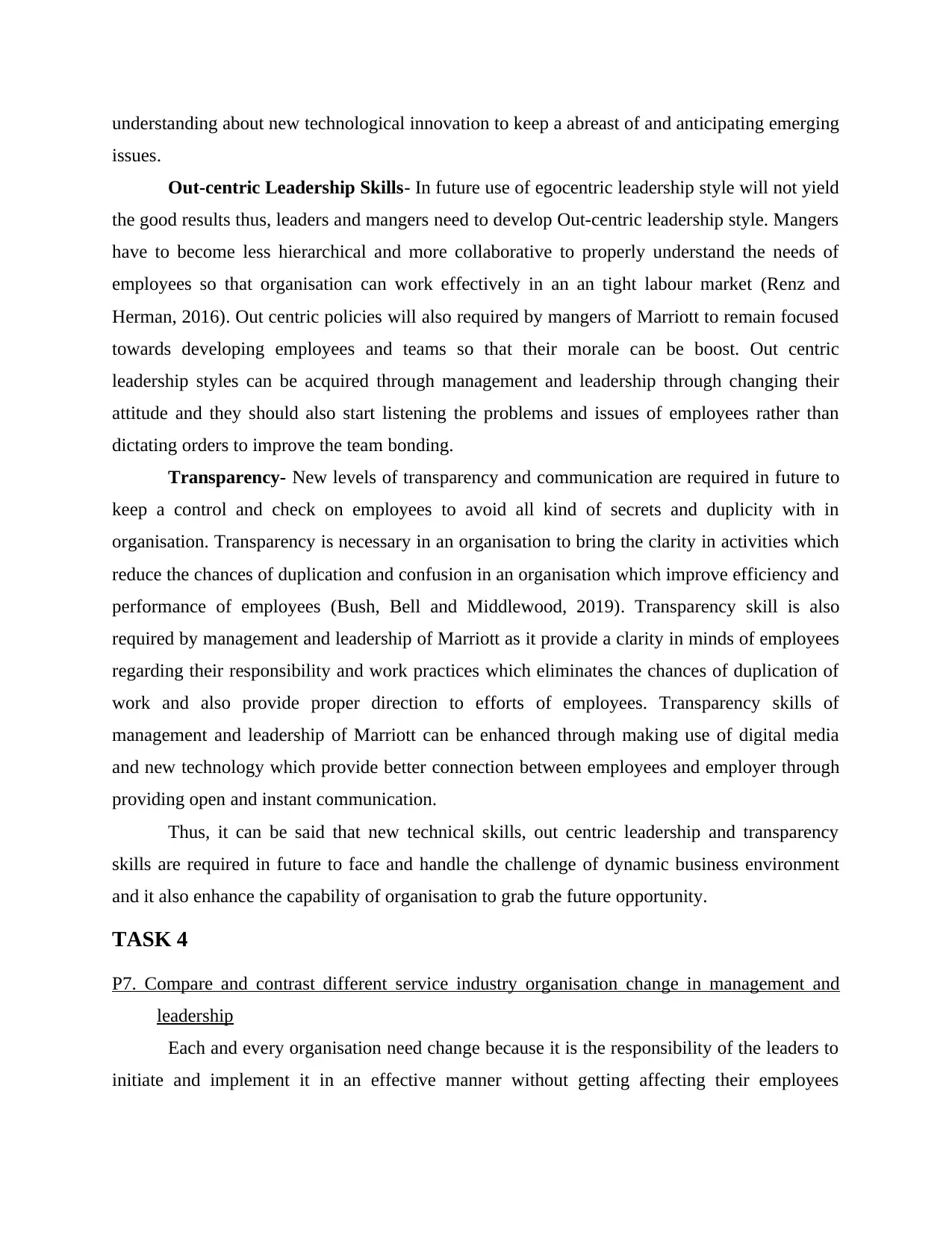
understanding about new technological innovation to keep a abreast of and anticipating emerging
issues.
Out-centric Leadership Skills- In future use of egocentric leadership style will not yield
the good results thus, leaders and mangers need to develop Out-centric leadership style. Mangers
have to become less hierarchical and more collaborative to properly understand the needs of
employees so that organisation can work effectively in an an tight labour market (Renz and
Herman, 2016). Out centric policies will also required by mangers of Marriott to remain focused
towards developing employees and teams so that their morale can be boost. Out centric
leadership styles can be acquired through management and leadership through changing their
attitude and they should also start listening the problems and issues of employees rather than
dictating orders to improve the team bonding.
Transparency- New levels of transparency and communication are required in future to
keep a control and check on employees to avoid all kind of secrets and duplicity with in
organisation. Transparency is necessary in an organisation to bring the clarity in activities which
reduce the chances of duplication and confusion in an organisation which improve efficiency and
performance of employees (Bush, Bell and Middlewood, 2019). Transparency skill is also
required by management and leadership of Marriott as it provide a clarity in minds of employees
regarding their responsibility and work practices which eliminates the chances of duplication of
work and also provide proper direction to efforts of employees. Transparency skills of
management and leadership of Marriott can be enhanced through making use of digital media
and new technology which provide better connection between employees and employer through
providing open and instant communication.
Thus, it can be said that new technical skills, out centric leadership and transparency
skills are required in future to face and handle the challenge of dynamic business environment
and it also enhance the capability of organisation to grab the future opportunity.
TASK 4
P7. Compare and contrast different service industry organisation change in management and
leadership
Each and every organisation need change because it is the responsibility of the leaders to
initiate and implement it in an effective manner without getting affecting their employees
issues.
Out-centric Leadership Skills- In future use of egocentric leadership style will not yield
the good results thus, leaders and mangers need to develop Out-centric leadership style. Mangers
have to become less hierarchical and more collaborative to properly understand the needs of
employees so that organisation can work effectively in an an tight labour market (Renz and
Herman, 2016). Out centric policies will also required by mangers of Marriott to remain focused
towards developing employees and teams so that their morale can be boost. Out centric
leadership styles can be acquired through management and leadership through changing their
attitude and they should also start listening the problems and issues of employees rather than
dictating orders to improve the team bonding.
Transparency- New levels of transparency and communication are required in future to
keep a control and check on employees to avoid all kind of secrets and duplicity with in
organisation. Transparency is necessary in an organisation to bring the clarity in activities which
reduce the chances of duplication and confusion in an organisation which improve efficiency and
performance of employees (Bush, Bell and Middlewood, 2019). Transparency skill is also
required by management and leadership of Marriott as it provide a clarity in minds of employees
regarding their responsibility and work practices which eliminates the chances of duplication of
work and also provide proper direction to efforts of employees. Transparency skills of
management and leadership of Marriott can be enhanced through making use of digital media
and new technology which provide better connection between employees and employer through
providing open and instant communication.
Thus, it can be said that new technical skills, out centric leadership and transparency
skills are required in future to face and handle the challenge of dynamic business environment
and it also enhance the capability of organisation to grab the future opportunity.
TASK 4
P7. Compare and contrast different service industry organisation change in management and
leadership
Each and every organisation need change because it is the responsibility of the leaders to
initiate and implement it in an effective manner without getting affecting their employees
⊘ This is a preview!⊘
Do you want full access?
Subscribe today to unlock all pages.

Trusted by 1+ million students worldwide
1 out of 18
Related Documents
Your All-in-One AI-Powered Toolkit for Academic Success.
+13062052269
info@desklib.com
Available 24*7 on WhatsApp / Email
![[object Object]](/_next/static/media/star-bottom.7253800d.svg)
Unlock your academic potential
Copyright © 2020–2025 A2Z Services. All Rights Reserved. Developed and managed by ZUCOL.



